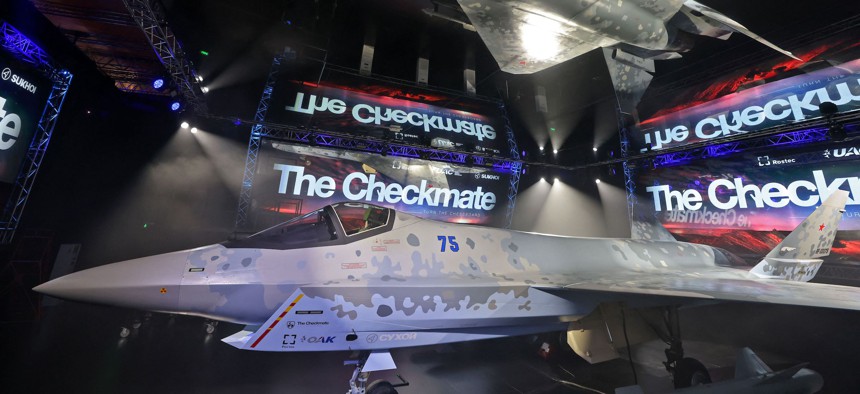
This picture taken on November 16, 2021 shows a view of the mockup and reflection of Russia's Sukhoi Su-75 "Checkmate" Light Tactical Aircraft on display during the 2021 Dubai Airshow. AFP via Getty Images / GIUSEPPE CACACE
Is Russia’s Su-75 ‘Checkmate’ Aircraft a Case of Vapor Marketing?
There’s less than meets the eye to the proposed fighter-bomber that made a splash at a recent industry show.
To hype their Su-75 "Checkmate" aircraft last month at the Dubai Air Show, officials from Russia’’s Sukhoi Design Bureau offered up bottles of a limited-edition Checkmate perfume. No fragrance, however, will mask how the Su-75 isn’t a light tactical fighter as advertised, but rather a medium-weight fighter-bomber similar to the F-16V.
During a Moscow air show last summer, Russia rolled out a mockup of the Su-75, a multi-purpose fighter-bomber designed to compete in the global marketplace — but only if it gets enough foreign orders to fund its manufacture. Rostec, Russia’s government arms production organization, is marketing it to any country that will listen to its pitch. Russian Deputy Prime Minister Yuri Borisov claims there is "an anchor customer” without naming it, but said it will be marketed to African nations, Vietnam, and India.
Diplomatic pressure from the United States and the prospect of sanctions have led several countries considering Russian-built weapons to shop elsewhere, as our recent study for RAND reported. But there are other reasons for buyers to beware, starting with the difficulty Sukhoi is having delivering its predecessor aircraft, the Su-57.
Russian aerospace industrial leaders claim that the Checkmate can be rapidly developed, mass-produced, and made available to foreign buyers later in this decade. A key assumption, though, is that the investment in the Su-57 can jump-start the Checkmate program. But the Su-57 has been in development nearly 15 years already, and Western analysts estimate that it still won’t be operational before 2027.
Russia has struggled to produce new jet engine models for several years because of sanctions and export restrictions imposed after it annexed Crimea in 2014. The first operational Su-57 will be equipped with the Saturn AL-41F1 low by-pass turbofan combat engine — the same engine that powers the Su-35, a heavy fighter-bomber designed in the 1980s. The new engine planned for the Su-57 is not slated for production until mid-decade, if then. Can countries realistically expect that Sukhoi will do better with the Checkmate?
Sukhoi also claims that Checkmate is a 5th-generation aircraft, but there are questions as to whether it will have advanced avionics and effective stealth capability. Western sanctions have also impeded the Russian aerospace and defense industry’s ability to get certain technologies essential to mass-produce its own advanced combat sensors with microprocessor subsystems. It may not have stealth capability at all: An analysis of Russian official media stories and Rostec press releases about Checkmate do not mention stealth technology. Without that, it’’s far-fetched to call this a 5th-generation aircraft.
Russian and Sukhoi marketers also say that Checkmate will be the cheapest 5th-generation fighter aircraft on the international arms market. It is difficult to imagine that the Su-57 production problems aren’’t going to require major investments, and that inevitably will drive up the price for Checkmate, too. Given how far the Su-57 production schedule has slipped, the prospect that the Su-75 will be available for foreign customers by 2025 also seems like more marketing hype.
Another problem looms for the whole Checkmate project: the demand for high-performance medium-weight fighter-bombers is waning. In developing countries, the market may be undermined by the dramatic success of armed drones in several conflicts. For example, Turkey destroyed Russian air defense systems and ground combat vehicles in Libya and Nagorno-Karabakh with precision guided missiles on Bayraktar TB2 unmanned aerial vehicles. The nature of warfare is changing and armed drones cost a fraction of the price of manned aircraft. Countries with scarce defense budgets may pass on Russia’s supposed 5th-generation fighter aircraft, no matter what features it is claimed to have.
Given the Russian aerospace sector’s difficulties in developing, let alone delivering, advanced combat aircraft, prospective Checkmate buyers should consider a range of options to meet defense needs. What’s attractive about the sales pitch may in the end just be marketing vapor that will simply evaporate.
John V. Parachini is a senior international and defense researcher at the nonprofit, nonpartisan RAND Corporation. He formerly directed RAND’s National Defense Research Institute’s Intelligence Policy Center.
Peter A. Wilson is an adjunct senior defense analyst at RAND and professor at the Security Studies Program, Georgetown University.



